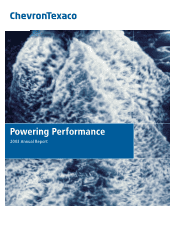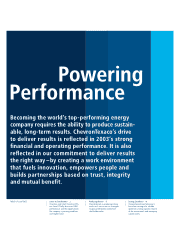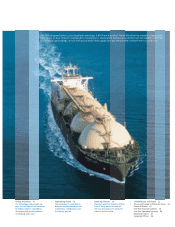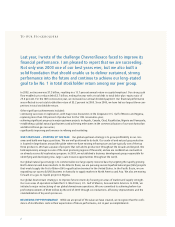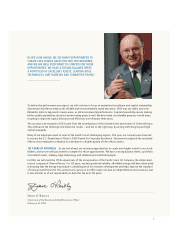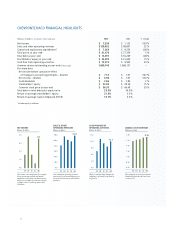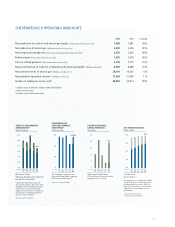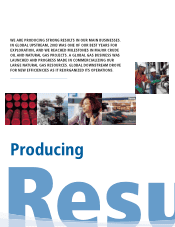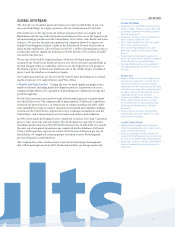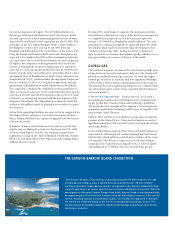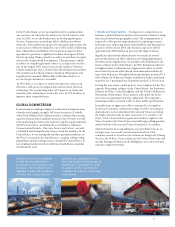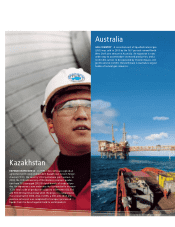Chevron 2003 Annual Report Download - page 10
Download and view the complete annual report
Please find page 10 of the 2003 Chevron annual report below. You can navigate through the pages in the report by either clicking on the pages listed below, or by using the keyword search tool below to find specific information within the annual report.
8
for two developments in Angola. The $1.9 billion Sanha con-
densate gas utilization and Bomboco crude oil project is under
way and expected to reach a maximum production rate of more
than 100,000 total barrels of oil-equivalent per day by 2006. The
first phase of the $2.2 billion Benguela Belize-Lobito Tomboco
development is expected to start up by late 2005 from the
Benguela and Belize fields. The second phase of the project will
bring the Lobito and Tomboco fields onstream. Both phases are
expected to be completed in 2007 with a maximum production
rate expected to exceed 200,000 total barrels of crude oil per day.
In Nigeria, the company reached agreements that cleared the
way for developing the deepwater Agbami project. Agbami is
expected to reach a maximum production rate of 250,000 total
barrels of crude oil per day within six to 12 months after it comes
onstream in 2007. In Kazakhstan, we hold a 50 percent interest in
Tengizchevroil (TCO), which includes the supergiant Tengiz and
Korolev oil fields. In 2003, TCO reached an agreement with the
government of Kazakhstan to expand operations in both fields.
The expansion, scheduled for completion in the second half of
2006, is expected to increase TCO’s crude oil production capacity
to between 430,000 and 500,000 barrels per day. In the U.S. Gulf
of Mexico, we are moving forward with the development of the
deepwater Tahiti Field. The Tahiti Field is estimated to hold 400
million to 500 million barrels of ultimately recoverable oil-equiva-
lent reserves.
In late 2004, upgrading facilities are expected to be completed for
the Hamaca heavy oil project. Located in Venezuela’s Orinoco
Basin, Hamaca will have the capacity to upgrade 190,000 barrels
of heavy oil per day.
A number of major exploration successes also were made dur-
ing the year, including discoveries in the deepwater U.S. Gulf
of Mexico and Nigeria. In 2003, the company acquired new
exploration acreage in the Gulf of Thailand, Plataforma Deltana
Block 2 in Venezuela, Block 249 in Nigeria and the Orphan Basin
offshore eastern Canada.
During 2003, work began to upgrade the upstream portfolio
and sell lower-value noncore assets. Sales have been announced
or completed for properties in North America, Papua New
Guinea, U.K. North Sea, Bangladesh and Kazakhstan. The com-
pany plans to continue to upgrade its upstream portfolio, while
investing in large crude oil and natural gas developments that
can deliver long-term value. Aiding our effort to build new
legacy positions is a business development group, which is assess-
ing opportunities in resource-rich areas of the world.
GLOBAL GAS
ChevronTexaco operates in some of the world’s most prolific natu-
ral gas basins and is well positioned to help meet the anticipated
growth in worldwide natural gas demand. We hold the largest
natural gas resources in Australia and have significant holdings
in West Africa, North America, Kazakhstan and Latin America.
The primary focus of our global gas business is to commercialize
our substantial equity resource base, targeting North American
and Asian markets.
> Results and Opportunities Early in the year, we created a
new global gas business that will integrate and coordinate natu-
ral gas production, transportation and marketing capabilities.
The group also has oversight of the company’s interest in power
generation, gasification technology and the gas-to-liquids (GTL)
joint venture, Sasol Chevron.
Early in 2003, Global Gas established a natural gas marketing
presence in the United States. It also reached milestones on key
liquefied natural gas (LNG) and GTL projects in both the Atlantic
and Pacific Basins.
In the Atlantic Basin, gas from West Africa and South America is
expected to be delivered to U.S. markets through the Port Pelican
LNG facility, which will be located 40 miles (64 km) off the coast
of Louisiana. Port Pelican is expected to be the first offshore
terminal in the United States to regasify LNG. It will be capable
of handling up to 1.6 billion cubic feet of natural gas per day.
Over the past 40 years, ChevronTexaco has produced some 300 million barrels of crude
oil from Barrow Island, a Class A Nature Reserve located 35 miles (56 km) offshore
northwest Australia. Today, Barrow Island is recognized as the industry standard for how
crude oil operations can coexist with the most sensitive and diverse ecosystems. With the
development of the giant Greater Gorgon Area fi elds, Barrow Island is now destined to be
an important part of our efforts to commercialize our natural gas resources. After careful
review, including rigorous environmental studies, state authorities approved in-principle
the limited use of Barrow Island as the site for a new liquefi ed natural gas facility. The
Greater Gorgon Area fi elds represent a signifi cant percentage of Australia’s total known
natural gas resources.
THE GORGON-BARROW ISLAND CONNECTION

